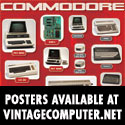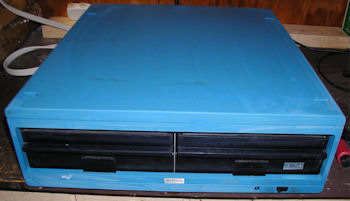A donation story
SHARE |
|
  A donation story
A donation story |
by Bill Degnan - 03/22/2008 23:26 |
|
As you may or may not know last year my VCF exhibit was supposed to be on the Exatron Stringy Floppy. A month before the show all my drive's belts snapped, and I had to switch my exhibit to a different subject. And that's why I did the TRS 80 Model 1 30th anniversary exhibit. Not my first choice, but that's the way it goes. hoo haa.
Since then I found a company to engineer replacement belts. It took 4 belt size/width attempts to finally get it right. Great, 6 months late but I finally had a working drive. I given the parts and such I accumulated I was able to assemble 3 working drives and I was able to use the belt for another related project that uses the same motor/belt. It pays to stick with things. "A donation story" Around lunchtime Friday I was working down stairs at my office in Wilmington, on the IBM Series 1 friends helped me move around Christmas time. The phone rings. The voice on the other end says. "Hey the TRS 80 I told you about is here, but you have to take it today" Shortly afterwards I went to pick up the lot. This wasn't just a normal TRS 80 model 1 (26-1006D) system. It was upgraded to 48K. It also had a special cable attached to the expansion slot. The cable provided the following functionality: 1) a port for a system clock device 2) a port for a Commodore/Atari-type joystick 3) ports for two Exatron Stringy Floppy drives! Following the cable through a slot in the desk and then along the underside it led to a little compartment that held the drives. Oh boy, a drive "1" Exatron stringy floppy drive. Wow. The lot also included a brand-new ~'80 Epson line printer and a kit for adding a parallel printer to a TRS 80 system. There was a tape drive, cables, etc. The only thing that was missing was software. Oh and ...also included in the lot: Odyssey II game system and games, all still in the boxes. AND a CollecoVision system with a ton a weird control paddles that I had never seen before. The TRS 80 system had been packed away nicely for 25 years with the original plastic covers. I took everything home. It took about three hours to clean all the equipment thoroughly, take apart the Exatron "0" and "1" drives, and to replace the drive belt in drive "0." Drive 1 had a different kind of motor that needed no belt. Nice. I powered on the TRS 80 system and did some testing. After some of my patent pending "exercising" techniques for restoring old electronics - Everything works! I was even able to format wafers in both the 0 and 1 drives, trade data, etc. Awesome. This stuff was free. I will post pictures when I get the chance. I am quite thankful for such good fortune, what a difference a year makes. If I had only gotten the call last year, but that's life. Thanks John..Happy Easter. Pictures of System Bill Reply |
|
  Video of Exatron Stringy Floppy
Video of Exatron Stringy Floppy |
by Bill Degnan - 05/31/2009 21:59 |
|
I made a quick video of the TRS 80 Model 1 with "custom" desk for two Exatron Stringy Floppy drives (drive 0 and 1). In the video I load the demo program for the drive.
http://www.youtube.com/watch?v=EBfNy021K2Q If you're interested, here is the command to load the first program on the 2nd drive @#1LOAD1 [return] @ = enter a command #1 = change default drive to 1 LOAD = load program on wafer 1 = first program on wafer Reply |
|
  Archiving Wafers to WAV
Archiving Wafers to WAV |
by Bill Degnan - 07/02/2009 23:05 |
|
Here is a set of useful tips by Terry Stewart in New Zealand. His web site is
http://www.classic-computers.org.nz ------------------- reprint from TRS-80 YahooGroups ------------------- Question: Is there any chance that these are actually some rare form of audio tape that we could record a WAV file of? There's no such thing as a wafer2dmk or wafer2cas or something, is there? Answer Do you have a working ESF and TRS-80? If so, it very doable. Matthew Reed's emulator can load in WAV files as cassette input. I've found it quite reliable. Here's what I would do. This is assuming a PC Windows environment 1. Connect the TRS-80 up to the Line Input socket of your soundcard in the PC. Load a sound editor like Audacity (it's free for download) into the PC and have it standing by. For BASIC Programs... 2a. When ready load in a ESF program from wafer 3a CSAVE the program out, capturing it in Audacity as a WAV file. 4a Test to see if the WAV loads into Matthew Reed's emulator. If it does, re-write it as a CAS or ESF image file for archiving. Alternatively you could keep the original WAV but they are much larger of course. FOR a machine language program. 2b. Find out the start, length and entry address by loading the program in the ESF holding the shift key down. Chances are it will load somewhere between 4300 and 7FFF 3b If you have ESF-80, you can write the memory segment straight out to the soundcard as above. An alternative is to load a monitor like TASMON in from tape, You have to watch you don't overwrite the program though. If you have 48k (non-disk) and a monitor program that sits right at the top of memory, that is ideal. Nearly all ESF programs occupy the first 16k and some large ones occupy most of it. 4b. Once written out as a WAV, you could load it into Matthew's emulator using the system command, You can then @save to program directly to a virtual wafer for archiving (or WAV or CAS). The ESF can co-exist with disk so disk monitor programs can be used. The problem is m/l ESF programs may be in the area from 4300 to 5200 where DOS resides. Hope this helps. I have a high memory version of TASMON as a WAV file I could throw on an FTP server if that is any help. Any cassette programs I use with my real TRS80 I load as a WAV from the PC through the soundcard using Audacity. Works just fine! Terry Reply |
|
Resources:

Popular Topics and FAQs
Past Issues:
Before we switched over to a blog format, past page archives here:
Vintage Computer Festival East 3.0 June 2006
Commodore B Series Prototypes July 2006
VOLSCAN - The first desktop computer with a GUI? Oct 2006
ROBOTS! - Will Robots Take Over? Nov 2006
Magnavox Mystery - a Computer, or? Jan 2007
The 1973 Williams Paddle Ball Arcade Computer Game Feb 2007
The Sperry UNIVAC 1219 Military Computer May 2007
VCF East 2007 - PET 30th Anniversary June/July 2007
The Electronic Brain August 2007
Community Memory and The People's Computer Company October 2007
Charles Babbage's Calculating Machine December 2007
Vintage Computing - A 1983 Perspective February 2008
Laptops and Portables May 2008
From Giant Brains to Hobby Computers - 1957 to 1977 August 2008
Historic Computer Magazines November 2008
World's Smallest Electronic Brain - Simon (1950) December 2008 - Feb 2009
Free Program Listings Spring 2009
Computer Music Summer 2009
Popular Electronics Jan/Feb 1975 - Altair 8800 Fall 2009
Early Microcomputer Mass Storage Summer 2010
Intel MDS 720 cleaned

This image was selected at random from the archive. Click image for more photos and files from this set.